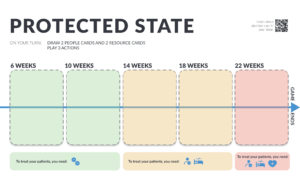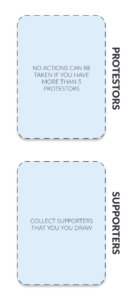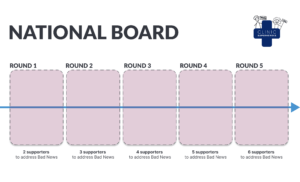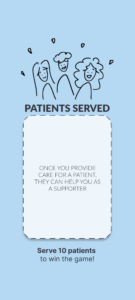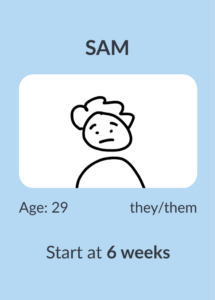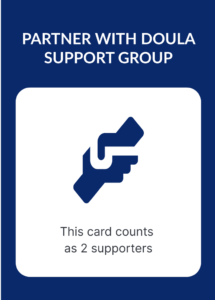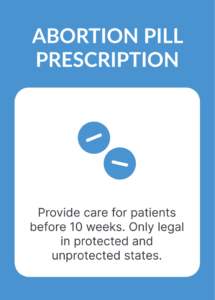Game Designers: Marielle Burt, Isabelle Lee, Alyssa Li, Ada Zhou
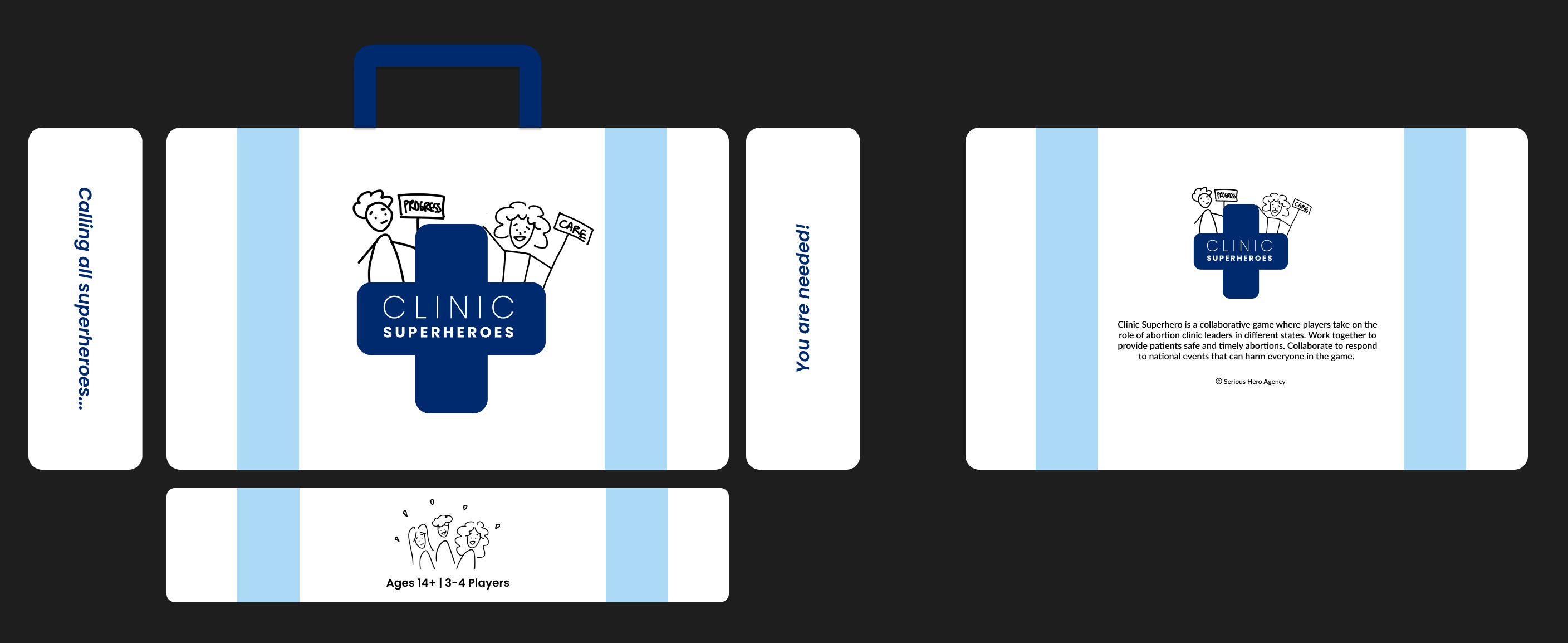
Overview
Since Roe v. Wade was overturned, access to abortion care has become severely limited and illegal in many states, and abortion clinics face new, complex barriers to providing vital care. Abortion clinics must strategize to navigate these restrictions, which vary drastically from state to state, while also advocating for a future where abortions are more safe and accessible.
Clinic Superheroes is a collaborative game where players take on the role of abortion clinic leaders in different states. Players work to provide their patients safe and timely abortions while collaborating with other abortion clinics to respond to national events that further restrict abortion access. This experience is designed to provide players a deeper understanding of differences in abortion care across states and inspire them to advocate for more equitable abortion access.
Clinic Superheroes is a game for 3-4 players, high school age and up. We designed the game with the hope that it could be shared in high school sexual health classes, college clubs where people have an expressed interest in learning more about abortion care, or in a casual table-top game night.
Our design choices seek to elicit several different types of fun: challenge, fellowship, and narrative. Clinic Superheroes is an intentionally difficult game, reflecting the reality of barriers to abortion access. Through strategy and collaboration, players are able to overcome these challenges. Moreover, the collaborative structure of this game is intended to build a sense of fellowship between players that will help them understand the value of community in working towards broader abortion access. Finally, the narrative elements of the game, such as helping patients, dispelling protesters, and gaining supporters add a level of pathos to game play.
Rules
See full rulebook here.
Game Components
See our Figma for a high-resolution version of all game components.
9 Boards
- 4 Player Boards (Protected, Unprotected, Hostile, Illegal)
- 4 Protestor/Supporter Placemats
- 1 National Board
- 1 Served Patients Placemat
176 Cards total
- 90 Resource Cards
- 20 each of Appointment and Procedure Cards
- 10 Abortion Pill Prescription Cards
- 8 Aftercare Cards
- 3 each of Special Resource Cards (Anonymous Donation, Education Campaign, Doula, Grant, Pro-Choice Rally, Expand Contraceptive Access)
- 9 Dispel Protestor cards
- 72 People Cards
- 30 Patients
- 24 Protestors
- 18 Supporters
- 10 Bad News Cards
- 4 Player Cheat Sheets
Other Materials
- You will need 1 fair coin for coin flips (not provided).
Assessment
Our three core learning goals for Clinic Superheroes are:
- To increase empathy for abortion clinic workers and people seeking abortions.
- To deepen players’ understanding of core differences in abortion access across four types of states (illegal, hostile, unprotected, and protected.)
- To help players to learn more about different ways to advocate for and support individuals seeking abortions.
The game design specifically targets each of these goals. By inviting players to take on the role of abortion clinic workers, the game helps build empathy for the difficulty of this experience. As players work together while following specific restrictions for their state, the game creates an opportunity for players to talk about the differences in care in the four different types of states. Several mechanics help players learn about abortion advocacy: the dispel protestor cards prompt players to recite text that explains why abortions should be protected, the support cards describe real-world actions and events that positively impact abortion clinics, and the bad news cards describe potential real-world events that negatively impact abortion clinics. Finally, we included a set of reflection questions to inspire deeper conversation about abortion access after gameplay.
In our final two playtests, emphatic reactions from players suggested that our game successfully produced our desired learning outcomes. Players talked about their clients with a sense of care and concern, making remarks such as, “We have to save Maria!” and “I need to treat Susan first, she has been waiting for so long!!” Similarly, players were united in their frustration with bad news events that harmed all abortion seekers, audibly wincing or proclaiming, “Oh no!” when a new bad news event was revealed. Even when the players won the game in our last play test, they decided to keep playing because they wanted to help as many patients as possible.
Players also expressed that they learned meaningful information about abortion access. Many players expressed a deeper knowledge about the inequity of care in different states. One player remarked that the game clearly communicates the time pressure of providing an abortion quickly, and that they understood more about how providing this care becomes more complicated later on in a pregnancy. The most important takeaway from the game seemed to be an understanding of the value of collaboration in expanding abortion access. Several players made comments about how the “us vs. the game” structure provided a strong parallel to our political reality.
Due to limited time, we did not have a chance to ask players about how this game might impact their actions in support of abortion beyond game play, though one player mentioned that she had a greater desire to research abortion inequity after playing. If we continue working on this game for our final project, we plan to do more in-depth inquiry about how the game experience contributes to a player’s attitude toward advocating for abortion in the future.
History
Prototype 1 — Low-Fidelity
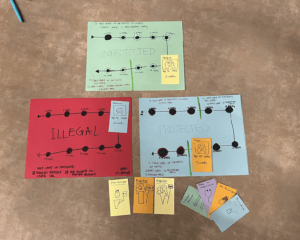
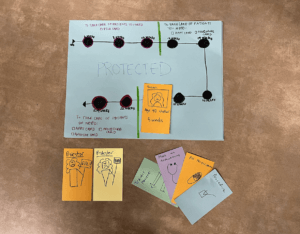
Key Characteristics
- The goal of the game is to individually treat as many patients as possible
- Every round is 2 weeks, and time intervals start from 6 weeks and end at 24 weeks
- 3 board types: Protected, Unprotected, and Illegal
- Various cards for protesters, patients, transferring patients, making appointments, pill prescriptions, and procedural abortions
Playtest 1 — 1/19

Players
- Henry
- Annie
- Carina
- Shana
Key Observations
- Players immediately asked about trading cards with each other and tended towards collaborative style playing, wanting it to be “Us vs. Machine”
- Ratio of the cards seemed off. For example: there were too many aftercare cards, and not enough appointment cards.
- Players had a hard time remembering everything they needed to do and could do during their turns
- More observations on a previous blog post
Key Changes Made Afterwards
- Created a national board that would pose game-wide restrictions that the players would collectively have to overcome in order to foster more collaborative gameplay and push the “Us vs. Machine” theme
- Incorporated a grant tracker so that players would have an easier time remembering how many rounds had passed before being able to use their grant
Prototype 2 — Low to Med-Fidelity
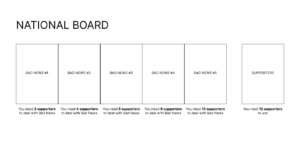
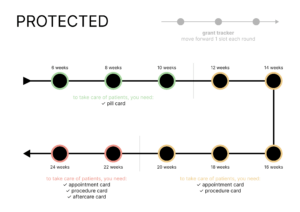
Key Characteristics
- National board to accumulate “bad news” cards that are combated cooperatively by all players.
- Bad news cards are randomly shuffled into the event card deck.
- Sleeker design of state boards with state-specific requirements listed and a grant tracker at the top right.
- Protected, Unprotected, Hostile, and Illegal boards.
Playtest 2 — 1/23

Players
- Miranda
- Ember
- Annie
- Ada (one of us)
Key Observations
- There are too many bad news cards in the event cards deck making the game feel too challenging.
- A win condition when players treat all the patients could foster more collaboration.
- Bad news status reminds players a lot of Secret Hitler. We could also consider adding good news.
- Reading the messages when dispelling protestors is fun, but didn’t come into play too much because not many were drawn.
Key Changes Made Afterwards
- After you treat a patient, they can become a supporter and help to dispel bad news.
- Players win when they treat 10 patients.
- Bad news cards must be played immediately after they are drawn, and can be removed after they have been dealt with, but will start stacking if they are not addressed.
- Patients stay at the same timeline spot even when they are transferred.
- Clarified the ways you can lose (community status cards fill up) and the number of treated patients needed to win.
- Put more supporters and protestors into the deck to even out the ratio.
- Changed community status board to require fewer supporters to dispel bad news.
Playtest 3 — 1/24
Players
- Mike
- Lucy
- Amy
- Charlotte
Key Observations
- Players cannot see the timeline on their state boards because patient cards cover it up.
- Players are struggling to keep track of rules and need a bigger and clearer cheat sheet.
- Players want more actions on their turns to make gameplay feel more active.
- Rules should incorporate images to be understood more easily.
- Players are confused when served patients become supporters if they should play these or the supporters in their hand first.
- Boards need spaces for supporters and protestors.
Key Changes Made Afterwards
- Added more actions for players on each turn.
- Added images to rules.
- Clarified that winning requires a certain number of served patients, and that using served patients to address bad news detracts from the total win.
Playtest 4 — 1/25 (Game Night)
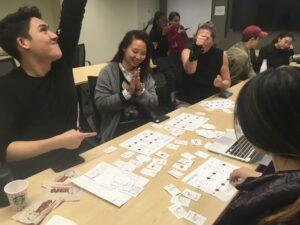
Players
- Gilbert
- Christina
- Lucy
- Shana
Key Observations
- Players were confused by which event cards they needed for each patient and proposed that we include the actual icons corresponding to patient needs instead of check marks on the state boards
- Players wondered what else they could do if they had extra actions left.
- Players proposed that some patients should start later in the timeline (e.g. 20 weeks) to make the game more challenging.
- Grants seemed very abstract and “magical” and were not very realistic.
- Players preferred bigger cards and shorter text.
Key Changes Made Afterwards
- Changed check marks to icons corresponding to patient needs on each state board
- Got rid of the grants and grant trackers and incorporated a variety of support cards to make aiding patients seem less abstract. New cards included: anonymous donation, start education campaign, partner with doula support group, win a grant, organize a pro-choice rally, and expand contraceptive access.
- Added a rule where unprotected and hostile states have to flip a coin for procedural abortions to determine if they can successfully treat a patient on their current round.
A Meaningful Quote
“Community and collective action are the only way forward.”
Prototype 3 — High-Fidelity Final
Key Characteristics
- Polished design made on Figma.
- Larger cards with more color and information, printed on cardstock.
- Removed grant tracker, added various support cards to have less abstract treatment of patients.
- Every round is now 4 weeks long, and time intervals start from 6 weeks and end at 22 weeks.
- Added side panels to manage accumulated protesters and supporters.
Playtest 5 — 1/26 (Final Playtest)
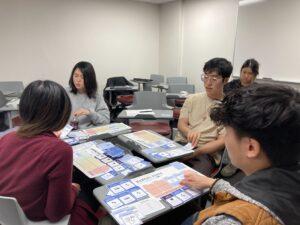
Players
- Shana
- Daniel
- Carina
- Ji Hong
Key Observations
- The rules are hard for people to grasp at the beginning, but they do better as they actually begin to play.
- The simplifications we made to the boards are easier for people to follow and speed up game play.
- The game almost seems too easy now! We might consider ways to make it more complicated.
Fun Quotes
- After finishing the game, Carina said, “Can we keep going? Let’s keep going!”
- Daniel let out a huge sigh after providing care for a patient.
Next Steps
In our final playtest, we discovered some important ways to improve the game. These included some smaller usability fixes as well as more meaningful alterations and ideas to explore further.
Immediate Usability Fixes
- Clarify if cards that say “before 10 weeks” mean <10 or <=10.
- Make sure every patient card has a different name, as there were some duplicates.
- Make the color scheme of all resource cards uniform to make their meaning clearer.
- Alter rules so that everyone draws the same number of cards, while players will still be able to play a different number of actions. This will maintain the disparity between states while simplifying rules to remember and streamlining gameplay.
Design Alterations and Ideas
- Review all aspects of the game that have rules on them and streamline how players access this information. It was too confusing when rules were spread between player board, cheat sheet, powerpoint, and a rules document.
- Potentially: make new cheat sheets that are specific for each state and explain the special rules they must obey. It was hard for players to understand that unprotected and hostile boards must flip coins for procedural abortions.
- Explore a new winning structure: Players are looking to see how many patients they can provide care to by the end of round 5. (We will include a metric in the rules detailing what an “Okay,” “Good,” “Great,” and “Super” score would be.)
- 1 point for every client you treated, -3 points for every client you fail to treat
- Make an Appendix for people who want to learn more about abortion rights.
- Explain more about how mechanics (e.g. coin toss) correlate to real life.
- List what real states fall into each category.
- Explain more about some of the bad news cards and support cards and their real-world relevance.
- Explore the possibility of a hand limit of 5 cards. Some players have to hold onto too many cards right now.
- Consider designing cards to lend themselves well to stacking (e.g. patient cards on the state board)
Links to Printable Materials
- Rules
- Game boards and cards
- Non-printable materials: 1 fair coin
Appendix
- Raw notes from our playtests


